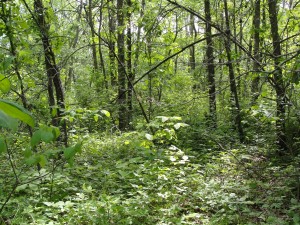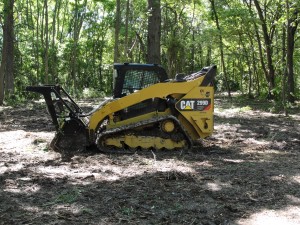The Professional Forester had recommended I call the District Conservationist at the local Service Center of the US Department of Agriculture.
“…and I want to call him because…?”
“First, he knows a lot about what you are trying to do and I think he’d be a good resource for you. Second, he knows other people in the county that could be useful to you in managing this forest. And Third, he controls grant money that can be used to underwrite your forest management activities.”
All of these seemed useful to me, so I called up the District Conservationist and made an appointment.

Monday morning at 9 am, I arrived, having just finished my coffee from the local MacDonald’s restaurant (#1, with Egg McMuffin, Hash Browns, and a Large Black Coffee.) He looked about 35, slender, with a pleasant, welcoming smile. His office was covered in maps and posters, and about 10 piles of assorted documents were sitting on his desk and credenza, which I took to be 10 different projects. I wondered if I would become one of his projects.
“Good Morning!” his smile widened. “I’m glad to meet you,” he said, genuinely.
“Thanks for taking the time to meet with me. My Professional Forester recommended I talk to you.”
I went on to explain my situation…I now owned a 33 acre forest and was trying to manage it with my Forest Management Plan, but I really had no experience or any kind of background at this. But I was actively trying to learn.
“I’ve worked with lots of non-resident land owners before, and I’m sure everything will work out fine. Can I look at your Forest Management Plan?”
I had made a copy for him to keep if he wanted, and handed it to him. I also handed him some pictures I had taken of the forest close to the gate. He paused for a couple minutes while skimming most of it, and reading some of it in detail. Then he stopped and looked up.
“So how are you thinking about approaching this?”
I explained about the Professional Forester’s recommendation that I get a Gator with a sprayer in the back, and attack the brush with a combination of herbicide, chain saw and weed trimmer. The look on his face told me that he had some misgivings about my strategy.
“There are several ways I can help you, and one of them is to give you some good advice. 33 acres is a lot of ground to cover, and doing it this way would probably take you a very long time, even if you were 25 years old. There’s a much smarter way.”
“And that smarter way is…?”
“You need to hire a Forest Mulcher Guy to come in with a Skid Steer with a Grinder attachment. It will cost you something around $150 an hour, but in that hour, he will accomplish more than you could accomplish in a year, doing it by hand. Once he’s done his work, you can come in behind him, and with your Gator, herbicide sprayer, weed trimmer and chain saw, you can maintain it pretty easily. But I think you’re going to have to invest in major, mechanical brush clearing before trying to manage this by yourself.”

I didn’t know what a Skid Steer or Grinder or Forest Mulcher was. But the District Conservationist explained that a Skid Steer is a smallish Caterpiller (or Caterpiller-like) machine, with an enclosed driver’s compartment. Attached to the front is a rapidly spinning steel grinder that chews up brush and small to medium-sized trees and turns them into mulch.
“Did you mention that there was grant money available for this?”
“In general, yes. Right at the moment, no. Grant money comes from the USDA in Washington and varies from year to year. It all is part of the Farm Bill. Right now, there are no funds available, and for the past couple years, there’s been very little conservation money. Prior to that, there was quite a bit of money.”
“So should I sign up for this, or wait until funding is available?”
“I’ve already got you on my list, and as soon as any funding becomes available, I’ll let you know and at that time you can apply.”
So the take-home message for me was:
- Find someone with a Caterpiller Skid Steer and Forest Mulcher, and
- Don’t plan on any government funding…you’re on your own.
